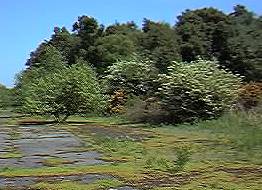
General view of part of the Common.
Note the Stonecrop growing on the old runway.
Back to the Index page
About a dozen members joined the trip to Skipwith Common on May 18th. The sun was shining although there was a brisk north-easterly breeze. We went on two walks through the reserve, one before lunch and one after. Unfortunately we did not see either the grass snakes or the lizards, probably because it was too cold, but we did see several butterflies, dragonflies and damsels, together with a splendid hairy caterpillar (Drinker moth), 29 species of birds and at least 80 different plants.

General view of part of the Common.
Note the Stonecrop growing on the old runway.
Skipwith Common is a YWT nature reserve which was a WWII airfield. The natural soil is peaty, developed on glacial deposits overlying Oxford Clay. The runways were laid on limestone gravel, so there is a wide range of soil types giving a rich patchwork of micro-habitats. The water in the various ponds on the reserve is neutral thanks to the runoff from the limy gravel, and two sorts of newts live here as well as frogs, toads, grass snakes, adders, lizards and slow-worms.
 (Left: Red Damsel on a nettle leaf.)
(Left: Red Damsel on a nettle leaf.)
We saw the following:
Mallard, Kestrel, Coot, Moorhen, Black-headed Gull, Wood Pigeon, Cuckoo, Swift, Swallow, House Martin, Robin, Song Thrush, Blackbird, Pied Wagtail, Treecreeper, Wren, Willow Warbler, Garden Warbler, Blackcap, Chiffchaff, Goldcrest, Blue Tit, Great Tit, Coal Tit, Long-tailed Tit, Carrion Crow, Chaffinch, Bullfinch and Yellowhammer.
 The list below is split into those plants seen in flower, those where only leaves were seen, and trees. It is not a complete list of all the plants seen, for instance I did not list all the common species present. I have not listed grasses or sedges except for one or two easily recognised ones (there are reedbeds at the edge of some of the ponds). Nor have I listed trees in any detail. It was interesting to note the effect of habitat on several of the species, for instance Common Mouse-Ear: on dampish verges they were tall and lush, but on the old runways where it was much drier the plants were dwarfed, often under an inch tall. (Right: Common Storksbill.)
The list below is split into those plants seen in flower, those where only leaves were seen, and trees. It is not a complete list of all the plants seen, for instance I did not list all the common species present. I have not listed grasses or sedges except for one or two easily recognised ones (there are reedbeds at the edge of some of the ponds). Nor have I listed trees in any detail. It was interesting to note the effect of habitat on several of the species, for instance Common Mouse-Ear: on dampish verges they were tall and lush, but on the old runways where it was much drier the plants were dwarfed, often under an inch tall. (Right: Common Storksbill.)
We saw a few fungi: Birch Bracket, Hoof, and a couple of small brown gill fungi.
Back to the Top
| English Name | Latin Name |
|---|---|
| Plants in Flower | |
| Alder Buckthorn | Frangula alnus |
| Alkanet, Green (intr.) | Pentaglottis sempervirens |
Amsinckia (intr.)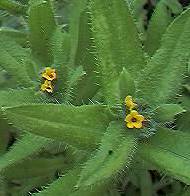 | Amsinckia intermedia Introduced from America; related to forget-me-nots. |
| Bluebell | Hyacinthoides nonscripta |
| Broom | Cytisus scoparius |
| Buttercup, Creeping | Ranunculus repens |
| Buttercup, Meadow | Ranunculus acris |
| Corydalis, Climbing or White | Ceratocapnos claviculata |
| Cotton Grass | Eriophorum angustifolium |
| Cow Parsley | Anthriscus sylvestris |
Cranesbill, Dovesfoot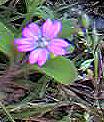 | Geranium molle This little cranesbill was growing on the old runways where it was very dry, so it was dwarfed (only about an inch tall). |
| Crosswort | Galium cruciata |
| Dead-nettle, White | Lamium album |
| Forget-me-not, Changing | Myosotis discolor |
| Forget-me-not, Field | Myosotis arvensis |
| Gorse | Ulex europaeus |
| Ground Ivy | Glechoma hederacea |
| Hawthorn | Crataegus monogyna |
| Hedge Garlic | Alliaria petiolata |
| Milkmaid, Lady’s Smock or Cuckoo-flower | Cardamine pratensis |
| Mouse-ear, Common | Cerastium fontanum |
| Nettle | Urtica dioica |
Pirri-pirri bur (intr.)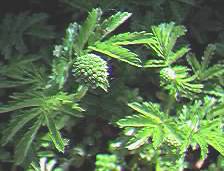 | Acaena anserinifolia Introduced from Australia or New Zealand, possibly brought in on the socks or boots of airmen! |
| Plantain, Ribwort | Plantago lanceolata |
| Pondweed, Common | Potamageton natans |
| Scarlet Pimpernel | Anagallis arvensis |
| Sedge, Hairy | Carex hirta |
| Silverweed | Potentilla anserina |
| Speedwell, Brooklime | Veronica beccabunga |
| Speedwell, Heath (?) [flowers very blue] | Veronica officinalis |
Speedwell, Germander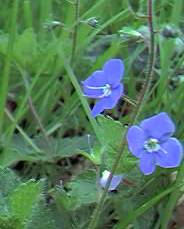 | Veronica chamaedrys |
| Speedwell, Wall | Veronica arvensis |
| Spikerush, Common | Eleocharis palustris |
| Stitchwort, Greater | Stellaria holostea |
Storksbill, Common | Erodium cicutarium This little plant was growing alongside the Dovesfoot Cranesbill on the old runways, and was dwarfed to approximately one inch tall. |
| Tormentil | Potentilla erecta |
| Tormentil (5-petalled variety) | Potentilla erecta |
| Whitlow Grass, Spring | Erophila verna |
| Wild Strawberry | Fragaria vesca |
| Wood Avens | Geum urbanum |
| Woodrush, Field | Luzula campestris |
| Woodrush, Heath | Luzula multiflora |
| Plants (Leaves only) | |
| “Bulrush” or Reedmace | Typha latifolia |
| Bracken | Pteridium aquilinum |
| Bramble | Rubus sp. |
| Broad Buckler Fern | Dryopteris dilatata |
| Burdock | Arctium sp. |
| Cinquefoil, Creeping | Potentilla reptans |
| Cleavers or Goosegrass | Galium aperine |
| Creeping Jenny | Lysimachia nummularia |
| Cross-leaved Heath | Erica tetralix |
| Dock, Broad-Leaved | Rumex obtusifolius |
| Figwort | Scrophularia nodosa |
| Helleborine | Epipactis helleborine |
| Hogweed | Heracleum sphondylium |
| Ling or Heather | Calluna vulgaris |
| Male Fern | Dryopteris filix-mas |
| Male Fern, Golden-scaled(?) | Dryopteris affinis |
| Marsh Horsetail | Equisetum palustre |
| Marsh Pennywort | Hydrocotyle vulgaris |
| Meadow Cranesbill | Geranium pratense |
| Orchid, Spotted (sp.) | Dactylorchis sp. |
| Parsley Piert | Aphanes arvensis |
| Red Bartsia | Odontites verna |
| Rowan | Sorbus aucuparia |
| Rush, hard | Juncus inflexus |
| Rush, soft | Juncus effusus |
| Spear Thistle | Cirsium vulgare |
| Spearwort, Lesser | Ranunculus flammula |
| Spring Vetch | Vicia lathyroides |
| Stonecrop, ?White or English | Sedum anglicum or album |
| Water Plantain | Alisma plantago-aquatica |
| Wild Rose | Rosa canina |
| Willow, Creeping | Salix repens |
| Woundwort, Hedge | Stachys sylvatica |
| Trees not included above | |
| Alder | Alnus glutinosa |
| Birch | Betula sp. |
| Hazel | Corylus avellana |
| Oak | Quercus sp. |
| Scots Pine | Pinus sylvestris |
| Willows (several) | Salix spp. |
Red Damsel |
Blue Damsel |
Brimstone (female) on dandelion  |
Large Red Damsel, Blue Damsel, Four Spotted Chaser (dragonfly), caterpillar of the Drinker Moth, Cinnabar Moth, Magpie Moth, Orange Tip Butterfly, Brimstone Butterfly (female and ?male), Green-veined White Butterfly.
All photos © copyright 1999 Gill & Adrian Smith
Back to the Top and Index page
© Ryedale Natural History Society 1999